April 26, 2024
Restoring Nature’s Balance: Rewilding in the Central Apennines
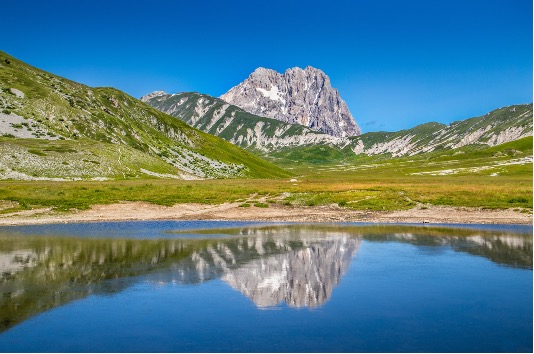
Introduction
The Apennine Mountain range, stretching for about 1400 km 1 from northern to southern Italy 2, is a key ecological passage and home to unique wildlife and highly diverse forests 3. (Fig. 1)
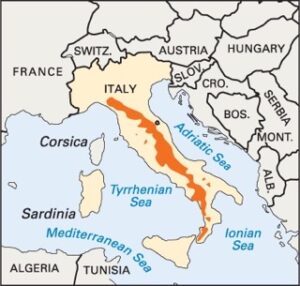
Understanding the Framework of The Apennines’ Rewilding Efforts
Rewilding the Apennine Mountains is crucial in restoring ecological balance and biodiversity in the face of significant environmental damage. Moreover, rewilding efforts have great potential in bringing back and protecting biodiversity as well as preserving ecosystems in the Apennine Mountain range. Possibly, the most important human impact in these Italian mountain ranges has been related to agricultural activities. Agriculture has always played a key role in Italy’s economy and history. However, as is known, such activities can often lead to loss of biodiversity, soil erosion 3, and changes in both biotic and abiotic factors. Italy, being an agricultural nation, was no exception. As settlements thrived, the natural balance of its mountains was lost. Changes in landscape structure and biodiversity were inevitable. The high diversity of native flora and fauna species that inhabited these mountains was endangered and species richness declined. Over time, however, livestock, especially free grazing, helped restore balance by keeping plant species at check and allowing important animal species to live in these areas. By doing so, nutrient cycling took place and the fertilized land aided plant species to grow healthy. Moreover, these agricultural activities contributed in the creation of new habitats and to the establishment of new predator-prey relationships.
Abandonment in these lands began to occur in the second half of the past century. An alarming mountain depopulation was observed by the end of the 1930’s. Maps reveal alterations since 1954 and by the end of the 1950’s, this depopulation had picked up significant pace 5. Coastal urbanization gained popularity, and this impacted the number of settlements in the mountains. Because of this, between 1960-2000, a significant increase in forest areas and a large decrease in pastures and natural agricultural land (grasslands) was observed. These grasslands were considered spaces for biodiversity, therefore, crucial for this ecosystem’s health. Since then, many policy makers have developed projects aiming to conserve the remaining grasslands in rewilding protected areas.
The changes in land-use, that is, transitioning from its natural state to farming and then returning to a natural state again, have posed a serious threat to forest ecosystems and diversity. Moreover, aging of all Apennine forests and an increase of living and dead biomass has been observed 6. This threat along with forests with old-growth characteristics have called for adaptation and mitigation measures 7. The reintroduction of key species such as the Marsican Bear, the Apennine Chamois, the Griffon Vultures, and crayfish represents a pivotal mitigation strategy in the current species extinction crisis. Although this is only one of many rewilding strategies, besides restoring these species to their natural habitats, this strategy aims to reestablish a healthy, self-regulating ecosystem. By promoting a similar biodiversity to that which existed before human activity, this initiative emphasizes the link between the reintroduction of species and the health of ecosystems, thus offering a promising avenue for sustainable biodiversity in the face of escalating environmental challenges.
The Marsican Brown Bear: The Apennines’ Guardian
One of the most significant rewilding efforts in the Central Apennines is the reintroduction of its apex predator: The Marsican Bear (Ursus arctus marsicanus). The Marsican Bear (Fig. 2) is a subspecies of the Brown Bear 8 and endemic to the Apennine Region of Central Italy 9. This estimated population of 50 bears inhabit an area of approximately 1500 -2000km2(although most live in the 500m2 National Park of Abruzzo Lazio and Molise (PNALM) 10, and has been isolated for hundreds of years from its northern counterpart. This number, although stable, represents a high risk of extinction. It is below the minimal threshold for long-term survival 11. Female population is low and this decreases genetic variability, which, in turn, compromises survival. Population of the Marsican Bear failed to increase despite the expansion of abandoned protected areas and connectivity among forest areas. Bear poaching and/or “accidental killings” have contributed to this stagnation 12. Perhaps the greatest human-wildlife conflict (HWC) is that carnivores prey upon livestock. Compensation programs by WWW-Italy have been set up to reimburse farmers with livestock. Nonetheless, this does not help ensure positive perceptions and attitudes towards the Marsican Bear. Ensuring positive attitudes is paramount to stop the loss of this species 12. Fear levels, negative personal experiences ,and lack of education and knowledge need to be overturned with effective livestock protection methods, especially female individuals, an increase in educational campaigns, and better communication and cooperation between all interested parties.
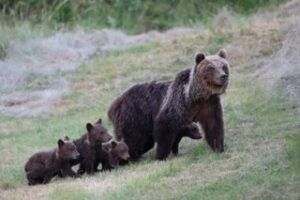
The most important conservation intervention has been the establishment of the PNALM in 1923. Its goal is to take measures for the prevention of habitat loss, supplementation of bear foods (reintroduction of deer populations) and feeding sites, and the creation of policies aimed in the reduction of human-bear conflicts 10. In addition, in order to promote habitat quality restoration and public awareness, 14 projects, amounting over $12 million, were funded by the European Commission under the Life-Nature program since 1994. Furthermore, in 2005, under the Abruzzo Region and the Italian Ministry for the Environment, the Action Plan for the Conservation of the Apennine Brown Bear (PATOM) was established 10. PATOM aims to overcome administrative fragmentation by adopting laws and regulations that can promote better and more coordinated land use, hunting regulations, anti-poaching campaigns, human dimensions, and livestock conflicts. Lastly, in 2006, the Wildlife Conservation Society, launched a five-year research and conservation project. Unfortunately, despite these efforts, to date, the bear population has shown no tendency to increase or expand its range.
The return of the Marsican Bear is a challenge and requires many efforts and responsibilities. The problems undermining the conservation efforts and projects must be overcome and new actions need to be considered. These actions include the development of a more strategic approach to unify authorities to coordinate conservation efforts, a new effort to control illegal killings, and research in collecting data that can be used to further protect this invaluable species 10. The large-scale, long-term recovery of this keystone species of the Apennines depends on the success of how we connect the dots between what is crucial for them and important for us.
Highlighting the Crucial Role of the Chamois: The Apennines’ Mountaineer
The Apennine chamois (Rupicapra pyrenaica ornata) (Fig.3 )is a vulnerable goat-antelope subspecies of the Chamois, native to the Central Apennines. Surviving only in the PNLAM (or ALMNP in English), and with a population of about 1, 100 individuals in the year 2006 20, it is strictly protected under Italian and international laws and considered an endangered species 21. This Apennine mountaineer has faced threats due to its limited and diminishing population as well as its low genetic variability. In the early 20th century, only one small population with few tens of individuals was left 20, it is strictly protected under Italian and international laws and considered an endangered species 21. In the 1970’s, after a century of population loss, the chamois population began its recovery. Despite this and even after its first reintroduction attempts in the Central Apennines in the late 1990’s 24, the chamois has faced a hard competition with red deer (Cevus elaphus), another reintroduced grazing species 21.
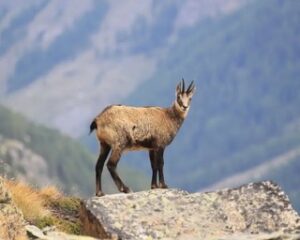
Despite this, reintroductions of the chamois have been successful. For example, a study monitored the 10 female and 6 male individuals from the year 2008-2010. Using global positioning radio tags. The success of reintroductions, such as this one, depends on factors such as the numbers of individuals released, their age and sex, their origin (whether they are wild or from captive-breeding, number of releases, habitat suitability, and connectivity amongst different populations 24. For the Apennine Chamois population to persist after a reintroduction, the ideal scenario is that the number of founders be large, that the rate of population increase, and that the effect of competition be low. Therefore, reintroduction programs should prepare the release site more carefully by removing former causes of extinction or present causes of population loss. Moreover, individuals should be monitored after their release to assess their ranging behavior and their response to their new environment 24.
Reviving the Skies: The Journey of Griffon Vultures from Decline to Reintroduction
The Eurasian Griffon Vulture (Gyps Fulvus), known as the Griffon Vulture (Fig. 4) , is a majestic and gregarious bird and a keystone species in the Apennines. Griffon vultures live in mountainous and sparsely populated areas 31. Griffon vultures are old world vultures and old world vultures are the most threatened group of birds and most threatened group of raptors. They feed on carrions of domestic and wild medium-large mammals, helping farmers with the disposal of carcass. These birds can switch from feeding sites to breeding sites. In this sense, they are very flexible in regards to their spatial behavior. They are able to cope with habitat changes and, therefore, have a pivotal role in maintaining the delicate balance of ecosystems, particularly when it comes to scavenging. Except for the Sardinian vulture, all vulture species began their population decline beginning in the 16th century and, in Italy, became extinct between the 19th and 20th century. Because their role, among other roles, prevented the spread of diseases and promoted overall ecosystem health, their downfall created a sense of global concern that led to reintroduction programs and the establishment of breeding centers.
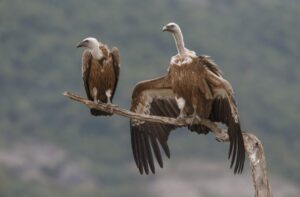
The availability of studies in regards to the rewilding of the Apennines by the reintroduction of this iconic bird is scarce. Because of this and the lack of hard data, supporting the management of Griffon vultures and planning conservation strategies is a difficult task. Nonetheless, one study reported that between December 2016 to October 2020, twenty vultures that had been captured and then reintroduced in the Central- Southern Apennines were monitored using solar powered gps tags and through satellite telemetry data. The most relevant data obtained from this were the survival estimates and the mortality causes. Poisoning and collision with turbines seem to be the most frequent causes of mortality, which are due to human action 34 . Other unknown causes of mortality were also reported. Mitigation strategies, then, should focus on anti-poison policies and measures for wind farmers.
From total decline to being at critical risk (CR) for a long time, to being now a “near threatened” species, the Griffon Vultures’ journey seems to finally be on its way to recovery.
Conclusion
Rewilding in the Apennine mountains signifies a joint effort for tackling the ecological consequences caused by centuries of human-wildlife conflicts. The Apennines have endured habitat loss, fragmentation, and a decline in species populations. However, despite these challenges, through rewilding initiatives, there is hope for restoring balance and reclaiming lost biodiversity and habitats.
The continued reintroduction and monitoring of keystone species such as the Marsican bear, the Apennine Chamois, and the Griffon Vulture is paramount. Because the Apennines are a testament of complex interaction between landscape dynamics, human activities, and conservation efforts 35, successful reintroduction programs have proven potential for native species and habitats to recover. The conservation of the apex predator of the Apennines, the Marsican bear, not only benefits the species, but it also has an effect on ecosystem dynamics. By restoring predator-prey relationships and promoting biodiversity, rewilding initiatives contribute to the resilience of ecosystems in the Apennine region. Carnivores can generate cascade effects on all other components of an ecosystem 36. Similarly, herbivores can significantly increase population dynamics and establish new competitions such as the successful reintroduction of the Apennine chamois. However, interspecific competition between Apennine chamois and red deer is an example of two species using the same limited resources with negative effects. Lastly, the Griffon Vulture also plays a pivotal role as a keystone species in the Apennines, aiding in the disposal of carcasses and maintaining the balance of ecosystems through scavenging. Living either in human dominated landscapes or human abandoned settlements involves many drawbacks for this native species 34 . Mortality rates increase, affecting its survival and conservation.
If nature is allowed to heal through minimal human intervention and key species are properly reintroduced and managed, then conservation efforts will not be in vain and ecosystems can revive. The ultimate goal is to rewild for the medium-long term and to have enough data to continue to improve all conservation strategies in the future. Mending ecosystems through rewilding and reintroduction efforts ensures a sustainable future for all. Moreover, effective planning and intervention and public support and funding are crucial for biodiversity conservation 35 . More importantly, the intricate relationships in the Central Apennines require a call to action for humans to step back and let the wild reclaim its rightful place.
- Vacchiano, Giorgio, Matteo Garbarino, Emanuele Lingua, and Renzo Motta. 2017. “Forest Dynamics and Disturbance Regimes in the Italian Apennines.” Forest Ecology and Management 388 (March): 57–66. https://doi.org/10.1016/j.foreco.2016.10.033. ↵
- https://www.tourissimo.travel/blog/apennines-the-other-italian-mountains#:~:text=The%20Apennines%20are%20the%20mountains,onto%20the%20island%20of%20Sicily. ↵
- Morales-Molino, César, Marianne Steffen, Stéphanie Samartin, Jaqueline F. N. van Leeuwen, Daniel Hürlimann, Elisa Vescovi, and Willy Tinner. 2021. “Long-Term Responses of Mediterranean Mountain Forests to Climate Change, Fire and Human Activities in the Northern Apennines (Italy).” Ecosystems 24 (6): 1361–77. https://doi.org/10.1007/s10021-020-00587-4. ↵
- Morales-Molino, César, Marianne Steffen, Stéphanie Samartin, Jaqueline F. N. van Leeuwen, Daniel Hürlimann, Elisa Vescovi, and Willy Tinner. 2021. “Long-Term Responses of Mediterranean Mountain Forests to Climate Change, Fire and Human Activities in the Northern Apennines (Italy).” Ecosystems 24 (6): 1361–77. https://doi.org/10.1007/s10021-020-00587-4. ↵
- Haller, Andreas, and Oliver Bender. 2018. “Among Rewilding Mountains: Grassland Conservation and Abandoned Settlements in the Northern Apennines.” Landscape Research 43 (8): 1068–84. https://doi.org/10.1080/01426397.2018.1495183. ↵
- Vacchiano, Giorgio, Matteo Garbarino, Emanuele Lingua, and Renzo Motta. 2017. “Forest Dynamics and Disturbance Regimes in the Italian Apennines.” Forest Ecology and Management 388 (March): 57–66. https://doi.org/10.1016/j.foreco.2016.10.033 ↵
- Morales-Molino, César, Marianne Steffen, Stéphanie Samartin, Jaqueline F. N. van Leeuwen, Daniel Hürlimann, Elisa Vescovi, and Willy Tinner. 2021. “Long-Term Responses of Mediterranean Mountain Forests to Climate Change, Fire and Human Activities in the Northern Apennines (Italy).” Ecosystems 24 (6): 1361–77. https://doi.org/10.1007/s10021-020-00587-4 ↵
- Di Francesco, Cristina Esmeralda, Leonardo Gentile, Vincenza Di Pirro, Lara Ladiana, Silvia Tagliabue, and Fulvio Marsilio. 2015. “Serologic Evidence for Selected Infectious Diseases in Marsican Brown Bears ( Ursus Arctos Marsicanus ) in Italy (2004–09).” Journal of Wildlife Diseases 51 (1): 209–13. https://doi.org/10.7589/2014-01-021. ↵
- Romagnuolo, Taea. n.d. “Can We Bear the Bear? Public Attitudes towards the Marsican Brown Bear (Ursus Arctos Marsicanus) in the Abruzzo Region, Italy, with Management Implications for Their Conservation.” ↵
- Ciucci, Paolo, and Luigi Boitani. 2008. “The Apennine Brown Bear: A Critical Review of Its Status and Conservation Problems.” Ursus 19 (2): 130–45. ↵
- Abruzzo, Ente Autonomo Parco Nazionale d’, and Lazio e Molise. 2015. “GUIDELINES FOR RELEASING MARSICAN BROWN BEAR CUBS INTO NATURE. ↵
- Romagnuolo, Taea. n.d. “Can We Bear the Bear? Public Attitudes towards the Marsican Brown Bear (Ursus Arctos Marsicanus) in the Abruzzo Region, Italy, with Management Implications for Their Conservation.”) ↵
- Romagnuolo, Taea. n.d. “Can We Bear the Bear? Public Attitudes towards the Marsican Brown Bear (Ursus Arctos Marsicanus) in the Abruzzo Region, Italy, with Management Implications for Their Conservation.”) ↵
- https://www.newscientist.com/article/2390457-killing-of-rare-italian-bear-raises-fears-for-future-of-its-subspecies/ ↵
- Abruzzo, Ente Autonomo Parco Nazionale d’, and Lazio e Molise. 2015. “GUIDELINES FOR RELEASING MARSICAN BROWN BEAR CUBS INTO NATURE. ↵
- Abruzzo, Ente Autonomo Parco Nazionale d’, and Lazio e Molise. 2015. “GUIDELINES FOR RELEASING MARSICAN BROWN BEAR CUBS INTO NATURE. ↵
- Ciucci, Paolo, and Luigi Boitani. 2008. “The Apennine Brown Bear: A Critical Review of Its Status and Conservation Problems.” Ursus 19 (2): 130–45. ↵
- Ciucci, Paolo, and Luigi Boitani. 2008. “The Apennine Brown Bear: A Critical Review of Its Status and Conservation Problems.” Ursus 19 (2): 130–45. ↵
- Ciucci, Paolo, and Luigi Boitani. 2008. “The Apennine Brown Bear: A Critical Review of Its Status and Conservation Problems.” Ursus 19 (2): 130–45. ↵
- Mari, Franco, and Sandro Lovari. 2006. “The Release of Apennine Chamois in Central Italy: 20 Years Later.” IUCN Reintroduction News Reintroduction News (January): 21–22. ↵
- Lovari, S., F. Ferretti, M. Corazza, I. Minder, N. Troiani, C. Ferrari, and A. Saddi. 2014. “Unexpected Consequences of Reintroductions: Competition between Reintroduced Red Deer and Apennine Chamois: Interactions between Red Deer and Apennine Chamois.” Animal Conservation 17 (4): 359–70. https://doi.org/10.1111/acv.12103 ↵
- Mari, Franco, and Sandro Lovari. 2006. “The Release of Apennine Chamois in Central Italy: 20 Years Later.” IUCN Reintroduction News Reintroduction News (January): 21–22. ↵
- Lovari, S., F. Ferretti, M. Corazza, I. Minder, N. Troiani, C. Ferrari, and A. Saddi. 2014. “Unexpected Consequences of Reintroductions: Competition between Reintroduced Red Deer and Apennine Chamois: Interactions between Red Deer and Apennine Chamois.” Animal Conservation 17 (4): 359–70. https://doi.org/10.1111/acv.12103 ↵
- Bocci, A., S. Menapace, S. Alemanno, and S. Lovari. 2016. “Conservation Introduction of the Threatened Apennine Chamois Rupicapra Pyrenaica Ornata: Post-Release Dispersal Differs between Wild-Caught and Captive Founders.” Oryx 50 (1): 128–33. https://doi.org/10.1017/S0030605314000039. ↵
- Lovari, S., F. Ferretti, M. Corazza, I. Minder, N. Troiani, C. Ferrari, and A. Saddi. 2014. “Unexpected Consequences of Reintroductions: Competition between Reintroduced Red Deer and Apennine Chamois: Interactions between Red Deer and Apennine Chamois.” Animal Conservation 17 (4): 359–70. https://doi.org/10.1111/acv.12103 ↵
- https://animalia.bio/chamois ↵
- Lovari, S., F. Ferretti, M. Corazza, I. Minder, N. Troiani, C. Ferrari, and A. Saddi. 2014. “Unexpected Consequences of Reintroductions: Competition between Reintroduced Red Deer and Apennine Chamois: Interactions between Red Deer and Apennine Chamois.” Animal Conservation 17 (4): 359–70. https://doi.org/10.1111/acv.12103 ↵
- Lovari, S., F. Ferretti, M. Corazza, I. Minder, N. Troiani, C. Ferrari, and A. Saddi. 2014. “Unexpected Consequences of Reintroductions: Competition between Reintroduced Red Deer and Apennine Chamois: Interactions between Red Deer and Apennine Chamois.” Animal Conservation 17 (4): 359–70. https://doi.org/10.1111/acv.12103 ↵
- Bocci, A., S. Menapace, S. Alemanno, and S. Lovari. 2016. “Conservation Introduction of the Threatened Apennine Chamois Rupicapra Pyrenaica Ornata: Post-Release Dispersal Differs between Wild-Caught and Captive Founders.” Oryx 50 (1): 128–33. https://doi.org/10.1017/S0030605314000039. ↵
- Bocci, A., S. Menapace, S. Alemanno, and S. Lovari. 2016. “Conservation Introduction of the Threatened Apennine Chamois Rupicapra Pyrenaica Ornata: Post-Release Dispersal Differs between Wild-Caught and Captive Founders.” Oryx 50 (1): 128–33. https://doi.org/10.1017/S0030605314000039. ↵
- Monti, Flavio, Pietro Serroni, Francesco Rotondaro, Alberto Sangiuliano, Andrea Sforzi, Giancarlo Opramolla, Antonello Pascazi, Samuele Spacca, Filippo La Civita, and Mario Posillico. 2023. “Survival of a Small Reintroduced Griffon Vulture Population in the Apennines: Insights from Global Positioning System Tracking.” Avian Biology Research 16 (1): 3–13.https://doi.org/10.1177/17581559221137309. ↵
- https://4vultures.org/vultures/griffon-vulture/ ↵
- Gouar, Pascaline Le, Alexandre Robert, Jean-Pierre Choisy, Sylvain Henriquet, Philippe Lecuyer, Christian Tessier, and François Sarrazin. 2008. “ROLES OF SURVIVAL AND DISPERSAL IN REINTRODUCTION SUCCESS OF GRIFFON VULTURE ( GYPS FULVUS ).” Ecological Applications 18 (4): 859–72. https://doi.org/10.1890/07-0854.1. ↵
- Monti, Flavio, Pietro Serroni, Francesco Rotondaro, Alberto Sangiuliano, Andrea Sforzi, Giancarlo Opramolla, Antonello Pascazi, Samuele Spacca, Filippo La Civita, and Mario Posillico. 2023. “Survival of a Small Reintroduced Griffon Vulture Population in the Apennines: Insights from Global Positioning System Tracking.” Avian Biology Research 16 (1): 3–13. https://doi.org/10.1177/17581559221137309. ↵
- Pallotta, Enrico, Lorenzo Boccia, Carlo M. Rossi, and Maria N. Ripa. 2022. “Forest Dynamic in the Italian Apennines.” Applied Sciences 12 (5). https://doi.org/10.3390/app12052474. ↵
- Lovari, S., F. Ferretti, M. Corazza, I. Minder, N. Troiani, C. Ferrari, and A. Saddi. 2014. “Unexpected Consequences of Reintroductions: Competition between Reintroduced Red Deer and Apennine Chamois: Interactions between Red Deer and Apennine Chamois.” Animal Conservation 17 (4): 359–70. https://doi.org/10.1111/acv.12103. ↵
- Monti, Flavio, Pietro Serroni, Francesco Rotondaro, Alberto Sangiuliano, Andrea Sforzi, Giancarlo Opramolla, Antonello Pascazi, Samuele Spacca, Filippo La Civita, and Mario Posillico. 2023. “Survival of a Small Reintroduced Griffon Vulture Population in the Apennines: Insights from Global Positioning System Tracking.” Avian Biology Research 16 (1): 3–13. https://doi.org/10.1177/17581559221137309. ↵
- Pallotta, Enrico, Lorenzo Boccia, Carlo M. Rossi, and Maria N. Ripa. 2022. “Forest Dynamic in the Italian Apennines.” Applied Sciences 12 (5). https://doi.org/10.3390/app12052474. ↵
Tags from the story
apennine mountain
apex predator
Italy
marsican bear
rewilding
